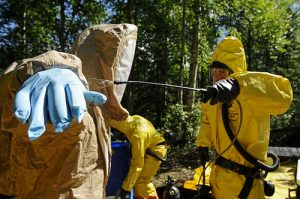During May, I’ll be discussing crisis communications on the Aubia Communications Blog. First up is this post about developing a crisis statement, followed by my first video post on how to deliver that statement, then I’m back at Syracuse University for my final class in crisis communications, and I’ll wrap it all up with some tips on handling a social media crisis.

At 7:30 a.m. EST Jan. 9, a resident in the Charleston, W.Va., area who lives near a chemical plant reported a strange smell. Three hours later, the company realizes it has a leak in a large storage tank, resulting in a later estimated release of 10,000 gallons of harmful chemicals. By 4 p.m., the company knows the leak has contaminated the water supply of 300,000 people. After a state government agency issues a warning that evening to not use the contaminated water, panic outbreaks among the town as residents make a mad dash for bottled water, causing riots at local grocery stores.
Other than reporting to government agencies, required by law, the chemical company remains mum on the event for more than 24 hours after it became aware of the crisis, not providing its first crisis statement until a press conference at 5:30 p.m. the next day. Due to the negative backlash of how poorly Freedom Industries handled the crisis, the company files for bankruptcy eight days after the leak was discovered, citing “as a result of the substantial media coverage related to this incident, vendors and customers of the debtor have made demands upon the debtor that it cannot readily satisfy without additional liquidity.”
Why you should have a crisis statement at the ready
Freedom Industries’ complete fail in public relations from waiting more than the standard one-hour-after-the-incident to make a crisis statement to the CEO drinking a bottled water during the press conference (For the life of me I can’t understand why big companies don’t get how unforgivable this is during a crisis dealing with the safety of drinking water! How hard is it to drink from a glass during times like these? Perception people!) is a lesson to learn from for crisis communications. Quickly addressing the situation to stakeholders is key to how well a company will recover from a crisis.
A prepared crisis statement saves you the agony of figuring out the right words to use while the building burns down around you, saving precious time at the most critical moments. Fill-in-the-blank statements addressing all your potential crisis events should come standard in your crisis communications plan. These statements are your first responses to the media, allowing for more follow-up at a later time. Just imagine the pandemonium that Freedom Industries may have been able to prevent if it had issued a statement about the leak and the corrective actions when it first learned of the problem.
What to include in a crisis statement
There are four areas to address in a crisis statement:
1. Situation
Address the facts as you know them, and don’t speculate or place blame. Your crisis statement should begin with a brief and straight-forward account of what occurred.
2. Sympathy
The spokesperson should be sincere and express sympathy for those killed or injured or those experiencing loss or damage. This is usually expressed as “Our thoughts and prayers are with those in the fire today who were injured and their families as the recover at the hospital” or some other similar sentiment.
3. Regret/Apology
If the crisis is man-made and at the fault of the company, apologize and take responsibility for the actions leading to the crisis. If the crisis is an Act of God or not at the fault of the company, you can still show empathy through regretting it even took place. Be sure this section of your crisis statement addresses all those affected by the incident, not just one segment.

4. Actions to Move Forward
Finally, wrap up your statements with what you’re doing to fix the problem, ensuring similar incidents don’t happen in the future. This can be “conducting a thorough investigation”, “re-training staff on procedures”, “re-evaluating policies”, or whatever it is you are doing to prevent potential crises.
Do you have a prepared crisis statement?
Crisis statements can vary from situation to situation, but the core concepts remain the same. Do you have some examples of statements you’ve used or found helpful? Let’s help each other out and share them in the comments.



